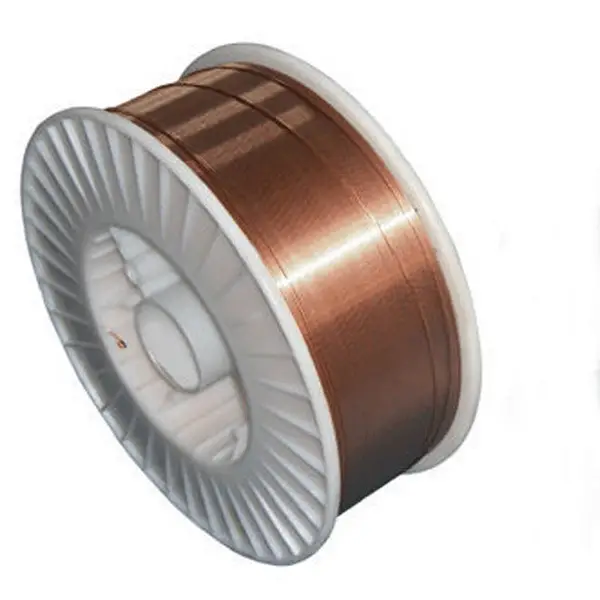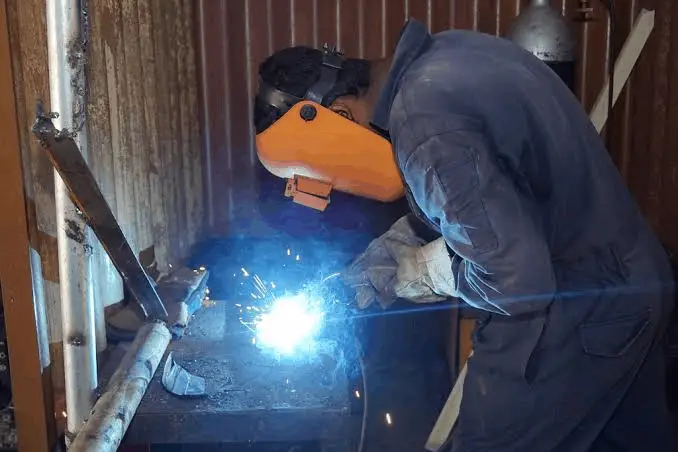Choosing the right welding wire is should be at the top when you are considering a wielding job. You then have to take into consideration the type of metals you are going to be wielding. The cost of the wielding wire while small when compared to labor and initial setup costs for wielder, can be significant if you make the wrong decision.
A good wire is vital for consistency and evenness of the weld. Poor quality wires increase the chances of destroying your materials.
Gas shielded arc welding wires (GMAW)
This is one of the most simple to learn wielding processes. In this technique, you have a shielding gas heating up metals along an electrode. With MIG there is the creation of an arc between the base metal and wire – an electric current is required for this. The resulting weld is strong and does not require any cleaning.
There are three main types of GMAW wires – composite GMAW wire, solid gas metal arc welding (GNAW) wire and the gas shielded flux cored wire.
Solid gas metal arc welding wire (GNAW)

One of the reasons welders will prefer the GNAW wire is because it is slagless and you spend less time in cleanup. The GNAW is either a composite metal cored or solid wire electrode. The strength of the welds produced with these types of wires depends on the shielding gas used and wire chemistry. GNAW wires vary depending on the deoxidizers used. For those that are highly deodorized expect them to handle light to medium surface contaminants. If you are in the market go for ER70S-6 that has higher levels of manganese than silicon. This is better than the ER 70S-3. At the middle is ER70S-4. When choosing the ideal GNAW wire ensure you get it from a reputable manufacturer as some wires do not meet American welding society standards but pass the European SG2 classifications.
Best usage for GNAW
Application varies for the GNAW wire depending on the metal you are working on. If you are doing a blasted plate then go for it, but if you are using a plate with heavy mill scale then go for a flux cored wire or metal cored wire. The reason for this is GNAW wires do not deoxidize the heavy mill scale well hence you have problems with the bead shape. For out of position welding, you can use the GNAW wire for thin materials by using the short arc procedure. The strength of the electrode plays a vital role in the weld deposit strength when using GNAW wires. This poses problems low allow base material that is of a high strength. In this scenarios you best bet is to go with the metal cored wires.
The other downside with GNAW wires is you have to be on the lookout for post weld cleanup especially when doing metal transfer for short arc or globular. You may experience more spatter.
Metal-cored wire
These is also called flux-cored wire and are tubular electrodes with a significant amount of metallic components in the core. Unlike the GNAW that has some post weld cleanup the metal cored wires have little cleanup. Due to their metallic composition, metal-core wires are well able to handle surface and mill scale contaminants better than the GNAW. If you are planning on blasting some material pre-welding then go with a metal-cored wire.
Usage
If you are to compare a solid wire of the same diameter with a metal-cored wire then you will notice that the metal core wire has a higher density at a given amperage. This leads to higher deposition rates. Applications of the metal cored wire differs but due to the high amperages used it may not be suitable for semi-automatic welding –especially for those with large diameters. For welders who make travel speed a priority then the metal core wire should be your first choice. For one it improves wetting for a plate with a mill scale. This leads to improved production rates in fabrication shops due to the low spatter. One benefit of using metal core wires is that you can add low metallic components to the core. This allows you to change the mechanic properties as you choose. It is ideal for low-alloy applications that have high strength. Unlike the GNAW, you have less cleanup with the metal core wire, though you may need to remove silicon islands before coating or painting the base metal.
Gas shielded wire (FCAW) wire
You can use these wires for both out of and in position welding. The FCAW wires contain a mixture of fluxing agents at their core and to protect the weld from outside contaminants have a significant quantity of deoxidizers. If you are thinking of working on dirty steel base metal then the FCAW wire is the best. Reason being the flux component acts a shielding gas. This means you can use the FCAW for high deposition applications. When choosing the FCAW wire go for those with a diameter of -0.035- to 116 inch diameter. For out-of-position welding go for E71T-1 or E71T-12.
The FCAW wire is ideal for many low alloy, high strength applications due to its slagging agents added to the core. The problem with the wire is it leaves a lot of slag making cleanup hard.
Type of metals
Your choice of metal will play a direct effect on the kind of wire that you choose. Most of the welding takes place on aluminum, carbon steel or stainless steel.
Additional wiring elements
It is common to have wires –especially for MIG welding to have a mixture of elements to enhance the properties of the wires. You will have the wires with a considerable amount of components like silicon, manganese, and titanium. Manufacturers add these components to make the wires stronger, stable and reduce chances of oxidation. Read the manufacturers manual to know what elements have been added to the wire.
Wire thickness
When welding you should know that the thickness of your base metal is the key determinant to the thickness of the wire you choose. Most sellers will have charts for wire thickness and ideal metals to use them on.
Consistency
Note that electrodes are not the same. When purchasing a wire look for consistency in the following areas – feedability, chemistry, arc performance, and wire diameter. Inconsistence wires will cost you in the end through lower productivity, inconsistent welds, and higher operating costs.
Common challenges with MIG wires

If you are looking for MIG wires then the best wires are ER70S-3 or ER70S-6. The wires meet minimum tensile strength of 70,000 PSI. Go for the ER70S-3 wire if you are welding a rust oil free material. The benefit of the wire is it helps you avoid silicon islands. Use the ER70S-6 for welding surfaces with contaminants or mill scale. The wire has a considerable amount of deodorizers that prevents oxidation of the weld.
The next thing you need be on the lookout for is porosity. This is when oxygen from the atmosphere combines with carbon to form carbon monoxide which forms bubbles in the weld. Most of the MIG wires in the market are known to have low hydrogen content. Porosity influences the weld wellness, metal fusion and freedom of the weld from cracking. To control this formation of carbon monoxide the spool arc wires will be reinforced with deoxidizers. With the titanium, aluminum and zirconium been better than the commonly used silicon and manganese.
You will also need to consider the fluidity of the weld puddle. The best puddles are the ones that wet out smoothly along the edges. This produce smooth, flat bead shapes. You will find such kind of bead shapes particularly important in multi-pass short arc welds. However, if you have excess puddle fluidity the performance of concave horizontal files and out-of-position welding is interfered with. The last step is to identify the right shielding gas. Most people use a ratio of 75% argon and 25% carbon dioxide. This produces less spatter than a combination of pure carbon dioxide.
Before you can start welding ensure you have the right safety apparatus. This means wearing leather boots and gloves and removing any fire hazards from your working area. You should add flame resistant jackets, welding helmet, and safety glasses. Some of these accessories actually come with the welding machine meaning you do not have to purchase them separately. If you are working on a rusty metal and you are using MIG welding then surface preparation is critical. MIG welding does not perform as well as flux core welding for rusty metal. This will mean you will need to grind the welding surface beforehand before you start welding.
Conclusion
Identifying the right welding wire greatly influences your welding results. Your type of metal will influence the kind of wire diameter that you use. If you are using MIG welding ensure that the wire spool properly fits your welder without too much or little tension. Wires often come with their own combination of deoxidizers and it is imperative that you go for one that offers maximum protection against oxidation.
